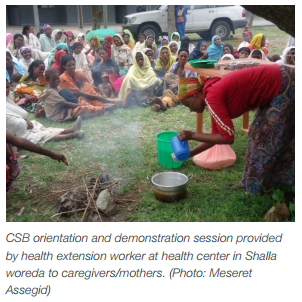A Snapshot of Evaluative Thinking: Emergency Food Assistance in Ethiopia
This brief post consolidates the key takeaways from the recent study “Embracing Evaluative Thinking For Better Outcomes,” conducted by InterAction and the Centre for Learning on Evaluation and Results for Anglophone Africa (CLEAR-AA). The case study featured in this post focuses on Catholic Relief Services' (CRS) work in Ethiopia. Most of the text is borrowed directly from the report. To learn more about evaluative thinking and the experiences of the four NGOs highlighted, please download the full report.
About Evaluative Thinking
At any given time, how do we know how effective our strategies, operations, or programs are? In other words, how do we assess the quality and value of our work? How do we know how well we are meeting the needs of those for whom we work? How will we know if our efforts are having any unintended effects, positive or negative, and for whom?
Finding out requires more than simply collecting and analyzing monitoring data or undertaking and using evaluations, since monitoring data on its own might not tell a full story, and evaluations might not anticipate and respond to all relevant questions. We also need to explore questions of quality, value, and importance, as well as how they inform our assumptions, judgments about what is good or not, and decision making.
Evaluative thinking is ongoing, systematic inquiry and learning about quality and perceptions of what is important.
Below is a summary of a case study from an emergency food assistance project in Ethiopia. It highlights why the organization decided to integrate evaluative thinking into its work, even if at the time they did not necessarily give what they were doing that name. It then describes the organization’s evaluative thinking processes and the decisions they informed; identifies factors that enabled evaluative thinking in the organizations, as well as challenges the team faced; and provides lessons learned useful beyond their organizational contexts. Much more information is provided in the full report.
Case Study Highlights
 When various monitoring and evaluation (M&E) activities revealed critical problems in corn soya blended (CSB) utilization, this emergency food assistance project, implemented by CRS, decided to reconsider how it had been using M&E and to take a more evaluative thinking approach among a consortium of NGOs.
When various monitoring and evaluation (M&E) activities revealed critical problems in corn soya blended (CSB) utilization, this emergency food assistance project, implemented by CRS, decided to reconsider how it had been using M&E and to take a more evaluative thinking approach among a consortium of NGOs.
Process: Evaluative thinking was applied to the following structures and processes: M&E Coordination, Program Management of Technical Working Groups, Implementing Partners' Organizational Structures, and Data Collection and Reflection
Enabling factors: The project established technical working groups and prioritized the introduction of M&E into emergency programming. CRS and its partners also recognized that to achieve the program’s intended goal, monitoring and evaluative thinking had to become part and parcel of the program.
Challenge: The greatest challenge to practicing evaluative thinking was bringing partners with different organizational cultures and objectives to the same page. Most partners did not take the emergency program as seriously as other development programs, seeing it simply as distributing emergency food aid.
Lessons learned: A strategic approach to evaluative thinking requires a clear vision for evaluation; a culture that fosters individual, group, and organizational learning; and a supportive environment. Establishing technical working groups, which considers a professional mix, allowed the program to undertake evidence-based decision making.
Read more case studies in evaluative thinking:



